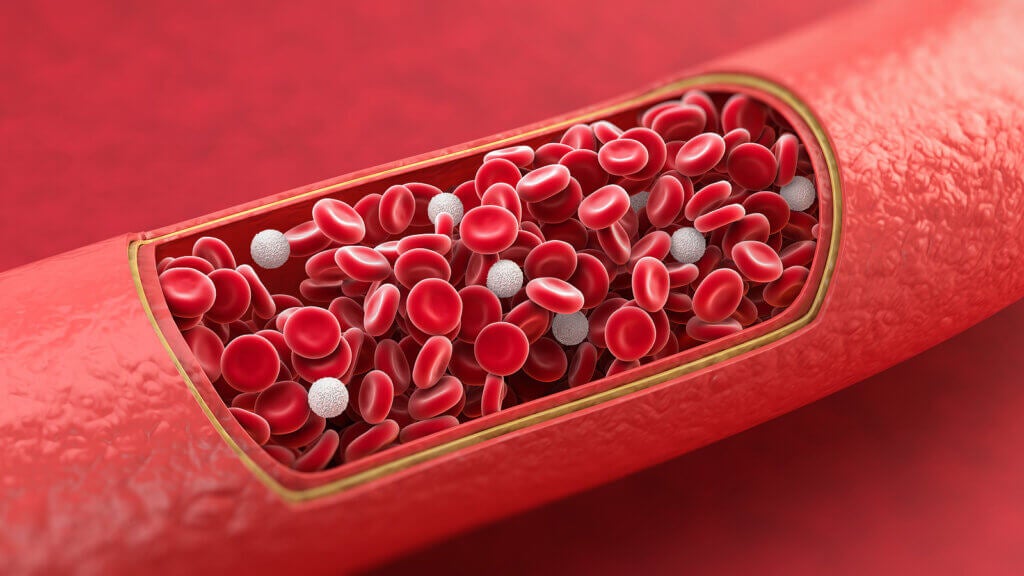The 10 Most Common Cardiovascular Diseases


Escrito y verificado por el biólogo Samuel Antonio Sánchez Amador
The circulatory or cardiovascular system is the set of organs and tissues responsible for the internal transport of oxygen and nutrients to each and every one of the body’s cells. The heart is the organic center of this system, pumping 4 to 6 liters of blood per minute. Unfortunately, there are certain common cardiovascular diseases that can disrupt blood flow.
Pathologies of the circulatory system are the leading cause of death in the world, as indicated by the World Health Organization (WHO). Some of them cause mild symptoms, while others (such as ischemic heart disease or stroke) have a very high fatality rate.
What are cardiovascular diseases and which are the most common?
According to the United States National Library of Medicine, cardiovascular disease is any problem that occurs in the heart, blood vessels, or both at the same time. Its origin can be congenital, hypertensive, ischemic, or inflammatory, and the appropriate specialist to treat these conditions is the cardiologist.
The WHO gives us a series of very interesting figures and data regarding cardiovascular diseases (CVDs). We summarize them in the following list:
- Cardiovascular diseases (CVDs) are the leading cause of death worldwide. In 2019, 17.9 million people died from a direct CVD. This represents 32% of global deaths.
- Of all the deaths caused by these conditions, 85% correspond to heart attacks and cerebrovascular accidents (CVAs).
- About 3/4 of CVD deaths occur in low-income or lower-middle-income countries. The lack of sanitary machinery claims many lives on this front.
- Of the more than 17 million premature deaths (before age 70) that are reported annually from noncommunicable diseases, CVDs are responsible for almost 40%.
- Most cardiovascular diseases are preventable, but their incidence is on the rise. A sedentary lifestyle, obesity, and a longer general life expectancy make them increasingly common.
As you can see, a failure in the circulatory system can pay dearly if it isn’t addressed in time. Next, we present the 10 most common cardiovascular diseases and their early symptoms, since detecting a pathology of this type quickly can mean the difference between life and death. Don’t stop reading.
1. Strokes (CVAs)

As indicated by the National Cancer Institute (NIH), a stroke is a pathology derived from the loss of blood flow to the brain, which translates into clear brain tissue damage. General symptoms of this condition include dizziness, numbness, weakness on one side of the body, trouble speaking, and difficulty understanding language.
The prevalence of strokes is very high, with an average of 8.6 cases detected per 1000 inhabitants. A person has a stroke in the United States every 40 seconds and every 4 minutes a patient dies from it. In this same country, each year more than 795,000 people experience a stroke.
If blood flow to a part of the brain is stopped for just a few seconds, neurons die and irreversible (or fatal) effects occur in the patient. Strokes can be ischemic or hemorrhagic. We show you their different types in the following lines.
1.1 Ischemic stroke
An ischemic stroke occurs when a blood vessel that supplies blood to the brain is blocked by a blood clot. This “plug” can occur in the narrowed artery itself (thrombotic stroke) or have detached itself from another part of the body and travel to an area of essential cerebral flow (embolic stroke). The latter is the most common type.
Ischemic stroke accounts for 80% of total strokes.
1.2 Hemorrhagic stroke
In this variant, a blood vessel in part of the brain weakens over time and ruptures, causing blood to leak into the brain tissue. There are many causes, such as the rupture of arteriovenous malformations such as aneurysms (which involve the widening and weakening of the walls of a blood vessel), trauma, or even as a complication of a previous ischemic stroke.
A stroke is a medical emergency that requires immediate attention. It’s a serious condition, as only 30% of patients survive 5 years after the accident.
2. Arrhythmias
Arrhythmias occur when the electrical impulses that coordinate the heartbeat don’t work properly. This causes the organ responsible for pumping blood to beat very slowly (bradycardia), very fast (tachycardia), or irregularly. Here are the most common types of arrhythmias in general society.
2.1 Atrial fibrillation (AF)
Atrial fibrillation is the most common type of arrhythmia in the world. In 2016 it was estimated that 46.3 million patients experienced it and its prevalence has increased by 3 in the last decades. It is characterized by an occasional or persistent fast heart rate of 100 to 175 beats per minute.
This leads to symptoms such as weakness, reduced exercise skills, fatigue, lightheadedness, dizziness, trouble breathing, and chest pain. Treatment is based on restoring the heart rhythm and controlling the rate (cardioversion), keeping it normal, and preventing blood clots.
Heart rate control is essential in arrhythmic conditions.
2.2 Ventricular tachycardia (VT)
This type of tachycardia occurs through the transmission of abnormal electrical signals to the lower chambers of the heart, the ventricles. This causes the heart rate to increase. Its general incidence isn’t entirely known, but it is known that together with ventricular fibrillation (VF) it’s the cause of 50% of cardiac deaths.
Depending on the general health of the heart and the duration of the tachycardia, the following can occur:
- Frequent fainting with loss of consciousness
- Heart failure
- Sudden death caused by a heart attack
The treatment goals are the same as in the previous case.
2.3 Long QT syndrome
In this type of tachycardia, the heart also beats fast, but it also beats chaotically. Long QT syndrome usually causes sudden fainting, seizures and, in severe cases, sudden death of the patient. The prevalence of the disease stands at 1 in every 2,500 live births.
Unlike the rest of the aforementioned tachycardias, long QT syndrome is almost always a hereditary condition, although there are more than 100 medications that can prolong the cardiac QT interval in apparently healthy people. Treatment is usually carried out with certain drugs, such as beta-blockers and mexiletine.
There are many more types of arrhythmias, but these represent some of the most common cardiovascular diseases of the group.
3. High blood pressure
Without a doubt, hypertension is one of the most common cardiovascular diseases in the world, if not the most widespread. It is estimated that there are more than 1.130 million people with hypertension and 2/3 of them live in low-middle-income countries. 1 in 4 men and 1 in 5 women are hypertensive, and only 1 in 5 patients actively control the condition.
Although it seems anecdotal and widespread in our society, it should be noted that hypertension is one of the main triggers of premature death throughout the planet. Some of the serious complications of this pathology are summarized in the following list:
- Heart attacks: Sustained high blood pressure can cause the arteries to harden and thicken (atherosclerosis ). This clinical picture exponentially increases the chances of suffering a heart attack.
- Strokes: Hypertension promotes the appearance of both ischemic and hemorrhagic strokes.
- Heart failure (HF): Hypertension is the most detected risk factor in patients with heart failure. If this condition is treated, the chances of presenting with HF are reduced by more than 50%.
A person is hypertensive when one or both blood pressure parameters (systolic and diastolic) are greater than the reference of 120-130 / 80 millimeters of mercury (mmHg).
The treatment of this condition always involves modifying the diet and adopting a healthier lifestyle, but drugs such as diuretics, angiotensin receptor antagonists, and calcium channel blockers are also required.
Around 9 out of 10 hypertensive patients have an incurable condition, but their symptoms can be kept at bay and complications from appearing.
4. Congenital heart disease (CC)
Congenital heart diseases are a group of cardiovascular diseases that cause problems in the structure and functioning of the heart from the moment the patient is born. It’s the main cause of death before the first year of life, and the conditions included in them can be divided into two categories that we’ll will mention below.
4.1 Cyanotic congenital heart disease
In these conditions, structural malformations cause blue or venous (low in oxygen) and red or arterial (rich in oxygen) blood to mix through abnormal blood channels. The condition causes the patient to suffer a clear lack of oxygen in their tissues, which manifests itself with a clinical picture called cyanosis.
Babies with cyanotic congenital heart disease have a marked bluish discoloration on the lips and fingers and toes. Apart from this, they can also exhibit symptoms of anxiety, hyperventilation, grayish skin, and permanent fatigue. Most conditions require open heart surgery to repair the heart defect.
4.2 Acyanotic congenital heart disease
In acyanotic congenital heart disease, blood flow in the lung remains constant and normal (or, at most, increases). They are also known as “pink” CCs, since the patient doesn’t show the tissue bluishness of cyanosis at birth. In any case, it’s still serious and promotes the appearance of murmurs and cardiomegaly, among other conditions.
5. Heart failure

The term heart failure is applied when the heart can no longer effectively pump oxygen-rich blood to the rest of the body. This causes a number of serious systemic symptoms, including coughing, fatigue, fainting, shortness of breath, liver vascular congestion, swelling of the feet and ankles, weight gain, and an irregular pulse.
Up to 1% of the population over 40 years of age will suffer from heart failure. The prevalence doubles with each decade of age and is up to 10% in people older than 70 years. It’s a progressive and fatal disorder and, even treated, causes death in 50% of cases 5 years after diagnosis.
Heart failure usually manifests after other disorders have damaged the heart throughout the life of the patient. Hypertension, defective heart valves, myocarditis, arrhythmias, and all the conditions that we have already mentioned can lead to this serious disease. There are many medicines and medical devices to delay its worsening.
Heart failure is one of the most common cardiovascular diseases in the aging population.
6. Coronary heart disease
We close this article with coronary heart disease, another of the most common and worrying cardiovascular diseases. Clinically, it’s a narrowing of the small blood vessels that supply blood and oxygen to the heart. It causes 4 million deaths annually in Europe and is the leading cause of death in the US, no more, no less.
Chest pain is the most common symptom, although in its early stages the disease can develop silently. The discomfort increases with physical exercise or during moments of strong emotions and is usually accompanied by fatigue and difficulty swallowing. It’s a condition that is caused by other of the aforementioned conditions, especially hypertension.
Smoking, high cholesterol, and lack of physical activity can also cause this clinical picture.
A very worrying group of diseases
In total we have told you about 10 types of common cardiovascular diseases, taking into account that cerebrovascular accidents, arrhythmias and congenital heart disease are divided into 2 or more separate clinical entities. All of them are of great concern and require an immediate approach, since, sooner or later, the chances of premature death increase.
As we have said in previous lines, cardiovascular conditions are the leading cause of death worldwide. You should maintain a healthy and active lifestyle if you want to delay the damage to the cardiovascular system, and if the patient feels any atypical symptoms, they should go immediately to the doctor. This is the only way to avoid sudden death from sudden heart failure.
The circulatory or cardiovascular system is the set of organs and tissues responsible for the internal transport of oxygen and nutrients to each and every one of the body’s cells. The heart is the organic center of this system, pumping 4 to 6 liters of blood per minute. Unfortunately, there are certain common cardiovascular diseases that can disrupt blood flow.
Pathologies of the circulatory system are the leading cause of death in the world, as indicated by the World Health Organization (WHO). Some of them cause mild symptoms, while others (such as ischemic heart disease or stroke) have a very high fatality rate.
What are cardiovascular diseases and which are the most common?
According to the United States National Library of Medicine, cardiovascular disease is any problem that occurs in the heart, blood vessels, or both at the same time. Its origin can be congenital, hypertensive, ischemic, or inflammatory, and the appropriate specialist to treat these conditions is the cardiologist.
The WHO gives us a series of very interesting figures and data regarding cardiovascular diseases (CVDs). We summarize them in the following list:
- Cardiovascular diseases (CVDs) are the leading cause of death worldwide. In 2019, 17.9 million people died from a direct CVD. This represents 32% of global deaths.
- Of all the deaths caused by these conditions, 85% correspond to heart attacks and cerebrovascular accidents (CVAs).
- About 3/4 of CVD deaths occur in low-income or lower-middle-income countries. The lack of sanitary machinery claims many lives on this front.
- Of the more than 17 million premature deaths (before age 70) that are reported annually from noncommunicable diseases, CVDs are responsible for almost 40%.
- Most cardiovascular diseases are preventable, but their incidence is on the rise. A sedentary lifestyle, obesity, and a longer general life expectancy make them increasingly common.
As you can see, a failure in the circulatory system can pay dearly if it isn’t addressed in time. Next, we present the 10 most common cardiovascular diseases and their early symptoms, since detecting a pathology of this type quickly can mean the difference between life and death. Don’t stop reading.
1. Strokes (CVAs)

As indicated by the National Cancer Institute (NIH), a stroke is a pathology derived from the loss of blood flow to the brain, which translates into clear brain tissue damage. General symptoms of this condition include dizziness, numbness, weakness on one side of the body, trouble speaking, and difficulty understanding language.
The prevalence of strokes is very high, with an average of 8.6 cases detected per 1000 inhabitants. A person has a stroke in the United States every 40 seconds and every 4 minutes a patient dies from it. In this same country, each year more than 795,000 people experience a stroke.
If blood flow to a part of the brain is stopped for just a few seconds, neurons die and irreversible (or fatal) effects occur in the patient. Strokes can be ischemic or hemorrhagic. We show you their different types in the following lines.
1.1 Ischemic stroke
An ischemic stroke occurs when a blood vessel that supplies blood to the brain is blocked by a blood clot. This “plug” can occur in the narrowed artery itself (thrombotic stroke) or have detached itself from another part of the body and travel to an area of essential cerebral flow (embolic stroke). The latter is the most common type.
Ischemic stroke accounts for 80% of total strokes.
1.2 Hemorrhagic stroke
In this variant, a blood vessel in part of the brain weakens over time and ruptures, causing blood to leak into the brain tissue. There are many causes, such as the rupture of arteriovenous malformations such as aneurysms (which involve the widening and weakening of the walls of a blood vessel), trauma, or even as a complication of a previous ischemic stroke.
A stroke is a medical emergency that requires immediate attention. It’s a serious condition, as only 30% of patients survive 5 years after the accident.
2. Arrhythmias
Arrhythmias occur when the electrical impulses that coordinate the heartbeat don’t work properly. This causes the organ responsible for pumping blood to beat very slowly (bradycardia), very fast (tachycardia), or irregularly. Here are the most common types of arrhythmias in general society.
2.1 Atrial fibrillation (AF)
Atrial fibrillation is the most common type of arrhythmia in the world. In 2016 it was estimated that 46.3 million patients experienced it and its prevalence has increased by 3 in the last decades. It is characterized by an occasional or persistent fast heart rate of 100 to 175 beats per minute.
This leads to symptoms such as weakness, reduced exercise skills, fatigue, lightheadedness, dizziness, trouble breathing, and chest pain. Treatment is based on restoring the heart rhythm and controlling the rate (cardioversion), keeping it normal, and preventing blood clots.
Heart rate control is essential in arrhythmic conditions.
2.2 Ventricular tachycardia (VT)
This type of tachycardia occurs through the transmission of abnormal electrical signals to the lower chambers of the heart, the ventricles. This causes the heart rate to increase. Its general incidence isn’t entirely known, but it is known that together with ventricular fibrillation (VF) it’s the cause of 50% of cardiac deaths.
Depending on the general health of the heart and the duration of the tachycardia, the following can occur:
- Frequent fainting with loss of consciousness
- Heart failure
- Sudden death caused by a heart attack
The treatment goals are the same as in the previous case.
2.3 Long QT syndrome
In this type of tachycardia, the heart also beats fast, but it also beats chaotically. Long QT syndrome usually causes sudden fainting, seizures and, in severe cases, sudden death of the patient. The prevalence of the disease stands at 1 in every 2,500 live births.
Unlike the rest of the aforementioned tachycardias, long QT syndrome is almost always a hereditary condition, although there are more than 100 medications that can prolong the cardiac QT interval in apparently healthy people. Treatment is usually carried out with certain drugs, such as beta-blockers and mexiletine.
There are many more types of arrhythmias, but these represent some of the most common cardiovascular diseases of the group.
3. High blood pressure
Without a doubt, hypertension is one of the most common cardiovascular diseases in the world, if not the most widespread. It is estimated that there are more than 1.130 million people with hypertension and 2/3 of them live in low-middle-income countries. 1 in 4 men and 1 in 5 women are hypertensive, and only 1 in 5 patients actively control the condition.
Although it seems anecdotal and widespread in our society, it should be noted that hypertension is one of the main triggers of premature death throughout the planet. Some of the serious complications of this pathology are summarized in the following list:
- Heart attacks: Sustained high blood pressure can cause the arteries to harden and thicken (atherosclerosis ). This clinical picture exponentially increases the chances of suffering a heart attack.
- Strokes: Hypertension promotes the appearance of both ischemic and hemorrhagic strokes.
- Heart failure (HF): Hypertension is the most detected risk factor in patients with heart failure. If this condition is treated, the chances of presenting with HF are reduced by more than 50%.
A person is hypertensive when one or both blood pressure parameters (systolic and diastolic) are greater than the reference of 120-130 / 80 millimeters of mercury (mmHg).
The treatment of this condition always involves modifying the diet and adopting a healthier lifestyle, but drugs such as diuretics, angiotensin receptor antagonists, and calcium channel blockers are also required.
Around 9 out of 10 hypertensive patients have an incurable condition, but their symptoms can be kept at bay and complications from appearing.
4. Congenital heart disease (CC)
Congenital heart diseases are a group of cardiovascular diseases that cause problems in the structure and functioning of the heart from the moment the patient is born. It’s the main cause of death before the first year of life, and the conditions included in them can be divided into two categories that we’ll will mention below.
4.1 Cyanotic congenital heart disease
In these conditions, structural malformations cause blue or venous (low in oxygen) and red or arterial (rich in oxygen) blood to mix through abnormal blood channels. The condition causes the patient to suffer a clear lack of oxygen in their tissues, which manifests itself with a clinical picture called cyanosis.
Babies with cyanotic congenital heart disease have a marked bluish discoloration on the lips and fingers and toes. Apart from this, they can also exhibit symptoms of anxiety, hyperventilation, grayish skin, and permanent fatigue. Most conditions require open heart surgery to repair the heart defect.
4.2 Acyanotic congenital heart disease
In acyanotic congenital heart disease, blood flow in the lung remains constant and normal (or, at most, increases). They are also known as “pink” CCs, since the patient doesn’t show the tissue bluishness of cyanosis at birth. In any case, it’s still serious and promotes the appearance of murmurs and cardiomegaly, among other conditions.
5. Heart failure

The term heart failure is applied when the heart can no longer effectively pump oxygen-rich blood to the rest of the body. This causes a number of serious systemic symptoms, including coughing, fatigue, fainting, shortness of breath, liver vascular congestion, swelling of the feet and ankles, weight gain, and an irregular pulse.
Up to 1% of the population over 40 years of age will suffer from heart failure. The prevalence doubles with each decade of age and is up to 10% in people older than 70 years. It’s a progressive and fatal disorder and, even treated, causes death in 50% of cases 5 years after diagnosis.
Heart failure usually manifests after other disorders have damaged the heart throughout the life of the patient. Hypertension, defective heart valves, myocarditis, arrhythmias, and all the conditions that we have already mentioned can lead to this serious disease. There are many medicines and medical devices to delay its worsening.
Heart failure is one of the most common cardiovascular diseases in the aging population.
6. Coronary heart disease
We close this article with coronary heart disease, another of the most common and worrying cardiovascular diseases. Clinically, it’s a narrowing of the small blood vessels that supply blood and oxygen to the heart. It causes 4 million deaths annually in Europe and is the leading cause of death in the US, no more, no less.
Chest pain is the most common symptom, although in its early stages the disease can develop silently. The discomfort increases with physical exercise or during moments of strong emotions and is usually accompanied by fatigue and difficulty swallowing. It’s a condition that is caused by other of the aforementioned conditions, especially hypertension.
Smoking, high cholesterol, and lack of physical activity can also cause this clinical picture.
A very worrying group of diseases
In total we have told you about 10 types of common cardiovascular diseases, taking into account that cerebrovascular accidents, arrhythmias and congenital heart disease are divided into 2 or more separate clinical entities. All of them are of great concern and require an immediate approach, since, sooner or later, the chances of premature death increase.
As we have said in previous lines, cardiovascular conditions are the leading cause of death worldwide. You should maintain a healthy and active lifestyle if you want to delay the damage to the cardiovascular system, and if the patient feels any atypical symptoms, they should go immediately to the doctor. This is the only way to avoid sudden death from sudden heart failure.
- Las 10 principales causas de defunción en el mundo, OMS. Recogido a 22 de agosto en https://www.who.int/es/news-room/fact-sheets/detail/the-top-10-causes-of-death
- Qué es la enfermedad cardiovascular, Medlineplus.gov. Recogido a 22 de agosto en https://medlineplus.gov/spanish/ency/patientinstructions/000759.htm#:~:text=La%20enfermedad%20cardiovascular%20es%20un,Esta%20acumulaci%C3%B3n%20se%20llama%20placa.
- Cardiovascular diseases, OMS. Recogido a 22 de agosto en https://www.who.int/news-room/fact-sheets/detail/cardiovascular-diseases-(cvds)
- Accidente cerebrovascular, NIH. Recogido a 22 de agosto en https://www.cancer.gov/espanol/publicaciones/diccionarios/diccionario-cancer/def/accidente-cerebrovascular
- Fibrilación auricular, Cardio Alianza. Recogido a 22 de agosto en https://cardioalianza.org/las-enfermedades-cardiovasculares/fibrilacion-auricular/
- Síndrome de QT largo, Orpha.net. Recogido a 22 de agosto en https://www.orpha.net/data/patho/Han/Int/es/SindromeQTLargo_Es_es_HAN_ORPHA768.pdf
- Rodríguez-Artalejo, F., Banegas, J. R. B., & Guallar-Castillón, P. (2004). Epidemiología de la insuficiencia cardíaca. Revista espanola de cardiologia, 57(2), 163-170.
Este texto se ofrece únicamente con propósitos informativos y no reemplaza la consulta con un profesional. Ante dudas, consulta a tu especialista.







